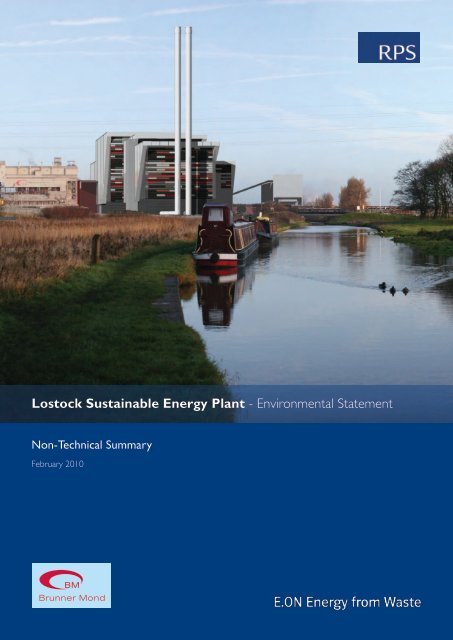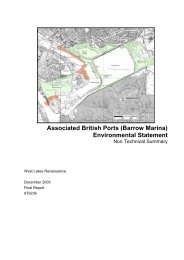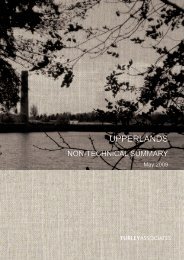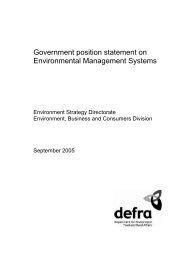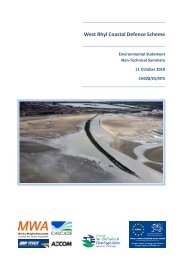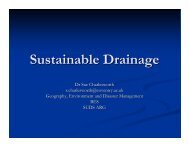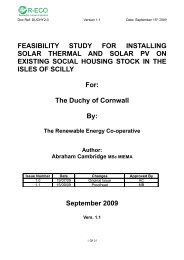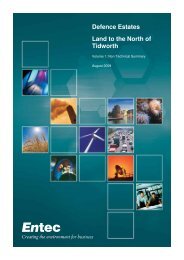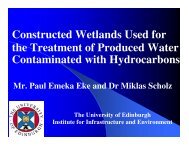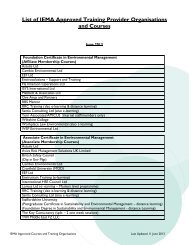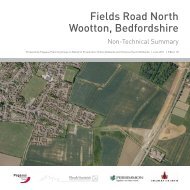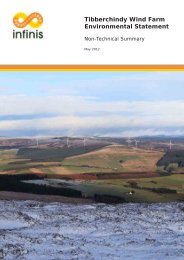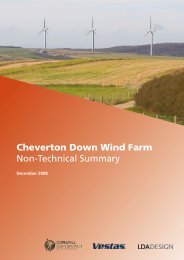Lostock Sustainable Energy Plant - Environmental Statement - IEMA
Lostock Sustainable Energy Plant - Environmental Statement - IEMA
Lostock Sustainable Energy Plant - Environmental Statement - IEMA
Create successful ePaper yourself
Turn your PDF publications into a flip-book with our unique Google optimized e-Paper software.
<strong>Lostock</strong> <strong>Sustainable</strong> <strong>Energy</strong> <strong>Plant</strong> - <strong>Environmental</strong> <strong>Statement</strong><br />
Non-Technical Summary<br />
February 2010
<strong>Sustainable</strong> <strong>Energy</strong> <strong>Plant</strong><br />
<strong>Lostock</strong>, Northwich, Cheshire<br />
<strong>Environmental</strong> <strong>Statement</strong>: Non-Technical Summary<br />
Prepared by:<br />
On behalf of Brunner Mond and E.ON <strong>Energy</strong> from Waste<br />
UK Limited<br />
February 2010<br />
RPS Planning & Development<br />
Mallams Court<br />
18 Milton Park<br />
Abingdon<br />
Oxon<br />
OX14 4RP<br />
Tel 01235 838 200<br />
Fax 01235 838 225<br />
Email rpsox@rpsgroup.com
Non Technical Summary<br />
Contents<br />
Page<br />
1 Introduction S1<br />
2 Why the Project is Needed S2<br />
3 The Project S4<br />
− Project Site and Description<br />
− Alternatives<br />
4 Consultation, Scoping and Methodology S8<br />
− Consultation<br />
− Further Consultation<br />
− Scoping<br />
− Methodology<br />
5 <strong>Environmental</strong> Effects S10<br />
− Introduction<br />
− Traffic and Transportation<br />
− Air and Climate<br />
− Landscape and Visual Effects<br />
− Ecology and Nature Conservation<br />
− Hydrology and Flood Risk<br />
− Hydrogeology and Ground Conditions<br />
− Noise and Vibration<br />
− Archaeology and Cultural Heritage<br />
− Socio-Economic Effects<br />
6 Further Information S18<br />
Figure<br />
Figure 1.1<br />
Figure 1.2<br />
Figure 2<br />
Figure 3<br />
Site Location<br />
Site Boundary<br />
Proposed Site Layout Plan<br />
Photomontage of Proposed SEP<br />
RPS<br />
February 2010<br />
S-i<br />
<strong>Lostock</strong> SEP<br />
<strong>Environmental</strong> <strong>Statement</strong>
Non Technical Summary<br />
1 Introduction<br />
1.1 On behalf of Brunner Mond and E.ON <strong>Energy</strong> from Waste UK Limited (the applicants), RPS<br />
has been instructed to undertake an <strong>Environmental</strong> Impact Assessment (EIA) and produce an<br />
<strong>Environmental</strong> <strong>Statement</strong> (ES) for a proposed <strong>Sustainable</strong> <strong>Energy</strong> <strong>Plant</strong> (SEP) on the site of<br />
the former <strong>Lostock</strong> Power Station, near Northwich, Cheshire.<br />
1.2 The ES accompanies an application to the Department of <strong>Energy</strong> and Climate Change<br />
(DECC) under Section 36 of the Electricity Act 1989 for development consent for the SEP.<br />
1.3 The ES has been prepared under the requirements of the Electricity Works (<strong>Environmental</strong><br />
Impact Assessment) (England and Wales) Regulations 2000 (the Regulations), as amended.<br />
Schedule 4 of those regulations requires that a summary of the ES be provided in nontechnical<br />
language.<br />
1.4 This Non-Technical Summary includes a summary of key information regarding the proposed<br />
SEP and how environmental and social issues will be addressed during the construction and<br />
future operation of the proposed SEP.<br />
1.5 The SEP would have an output of up to 60 Megawatts of electricity (MWe). The SEP would<br />
also be capable of producing up to 100 tonnes of steam per hour for supply to Brunner Mond.<br />
In order to produce this output, the SEP would require about 600,000 tonnes of fuel, in the<br />
form of non hazardous pre-treated waste derived fuel a year.<br />
1.6 The SEP would improve the overall sustainability of energy use by Brunner Mond, providing<br />
approximately one third of the required heat energy at the site and therefore displacing a<br />
significant quantity of fossil fuel. Operation of the proposed SEP would contribute to the<br />
reduction in greenhouse gases.<br />
RPS<br />
February 2010<br />
S-1<br />
<strong>Lostock</strong> SEP<br />
<strong>Environmental</strong> <strong>Statement</strong>
Non Technical Summary<br />
2 Why the Project is Needed<br />
Need for the Project<br />
2.1 The proposed SEP would improve the overall sustainability of energy use at the Brunner<br />
Mond sites providing approximately one third of the required heat energy and therefore<br />
resulting in a significant reduction in the use of fossil fuels and production of renewable<br />
energy from a good quality facility.<br />
2.2 <strong>Energy</strong> policy highlights the need for energy from waste projects. The most recent guidance,<br />
draft National Policy <strong>Statement</strong>s for <strong>Energy</strong> set out the Governments position on energy<br />
infrastructure. The Draft National Policy <strong>Statement</strong> for Renewable <strong>Energy</strong> Infrastructure (EN-<br />
3) states that there is a significant need for new major energy infrastructure.<br />
2.3 In addition to providing a substantial part of the required energy for Brunner Mond’s<br />
operations, the proposed SEP would contribute towards the aims of waste policy by reducing<br />
the UK's reliance upon landfill as a final destination for waste. This aim is set out in policy at<br />
European, national and regional levels. At each level, measurable objectives for that<br />
reduction are provided with incremental targets set over time.<br />
2.4 It is recognised that the continuing practice of large scale landfilling of waste represents a<br />
missed opportunity and the potential to reuse a large proportion of that waste is being<br />
overlooked. In the case of waste that cannot be recycled, its use as a fuel material is the next<br />
most appropriate in terms of the waste hierarchy.<br />
Alternatives Considered<br />
2.5 A review of possible alternative sites for the project has been carried out. A key consideration<br />
is that a primary purpose of the proposed energy from waste facility would be to supply steam<br />
to the <strong>Lostock</strong> site. Given that it is not practical to transport steam over long distances, sites<br />
on or close to the <strong>Lostock</strong> or Winnington sites were considered to be preferable.<br />
2.6 Sites at both <strong>Lostock</strong> and Winnington owned by Brunner Mond were considered for the<br />
proposed SEP.<br />
2.7 The <strong>Lostock</strong> site has an existing rail link from the Manchester-Chester railway line. In<br />
addition, the site has existing rail sidings that could be used to receive and off-load fuel. The<br />
site can also be accessed from the A530, which connects to the M6 south at Junction 18<br />
(Middlewich), with the A559 to the north, the A556 east to the M6/M60 north and Manchester<br />
and to the west to Chester and North Wales.<br />
2.8 The Winnington site also has a rail connection, but suitable off loading facilities would be<br />
more difficult to achieve. In addition, the site’s location in relation to the Northwich urban area<br />
is less favourable in traffic terms.<br />
RPS<br />
February 2010<br />
S-2<br />
<strong>Lostock</strong> SEP<br />
<strong>Environmental</strong> <strong>Statement</strong>
Non Technical Summary<br />
2.9 In terms of the likely environmental effects, it is noted that the land at <strong>Lostock</strong> is previously<br />
developed land currently occupied by the former <strong>Lostock</strong> Power Station. The site has<br />
therefore been previously used for energy generation purposes and is currently occupied by<br />
buildings formerly used for that purpose. The new SEP would thus continue with a similar<br />
land use, replacing a former power station with a modern plant operated to current standards.<br />
2.10 Sufficient land would be available at both sites. Following demolition of the existing power<br />
station, the site at <strong>Lostock</strong> would be large enough to accommodate the project with a suitable<br />
layout for efficient plant operation. There is an adjoining area of land that is suitable for<br />
temporary use as a laydown area for construction materials.<br />
2.11 In terms of local planning policy, much of the land required at the <strong>Lostock</strong> site is also allocated<br />
in the Cheshire Waste Local Plan 2007 for waste management uses, including thermal<br />
treatment. The land at Winnington is not allocated in the Waste Local Plan.<br />
2.12 On balance, the <strong>Lostock</strong> site was chosen as the preferred site for a number of reasons. The<br />
site benefits from better road access with appropriate rail facilities more easily provided. Use<br />
of the <strong>Lostock</strong> site would continue the former land use and involve similar features to the<br />
former power generating station. These reasons are considered to be sufficient, but are<br />
strongly reinforced by the fact that land at <strong>Lostock</strong> is allocated in the Waste Local Plan for<br />
waste management purposes including thermal treatment.<br />
2.13 Alternative site layouts and technologies have also been considered within the <strong>Environmental</strong><br />
<strong>Statement</strong>. A number of site layouts were considered, leading to the selection of the current<br />
design and site layout as most appropriate for the site. No more suitable alternative<br />
technologies were identified.<br />
RPS<br />
February 2010<br />
S-3<br />
<strong>Lostock</strong> SEP<br />
<strong>Environmental</strong> <strong>Statement</strong>
Non Technical Summary<br />
3 Project<br />
Key Characteristics of the Project<br />
3.1 The applicants propose to develop a <strong>Sustainable</strong> <strong>Energy</strong> <strong>Plant</strong> (SEP) on the site of the former<br />
power station on the existing Brunner Mond site at <strong>Lostock</strong>. The proposed SEP would have a<br />
total gross maximum electricity capacity of up to 60 MWe gross (53 MWe net) and would be<br />
capable of producing approximately 100 tonnes of steam per hour directly to Brunner Mond.<br />
The SEP would consume approximately 600,000 tonnes of pre-treated waste derived fuel per<br />
annum (tpa). The plant would improve the overall sustainability of energy use by Brunner<br />
Mond, providing approximately one third of the required heat energy at the site and therefore<br />
displacing a significant quantity of fossil fuel.<br />
3.2 The application site, as shown in Figures 1.1 and 1.2, occupies an area of approximately 9.2<br />
ha. This includes the following components:<br />
• Main SEP site, including Ash Handling Facility and Rail Reception Facility: 6.4 ha;<br />
• Construction laydown area for main site: 1.9 ha;<br />
• Relocated coke store: 0.9 ha.<br />
3.3 The main SEP site comprises an area of approximately 6.4 ha on the site of the former<br />
<strong>Lostock</strong> Power Station site (now redundant). The site is bounded to the east by the Trent<br />
and Mersey Canal and to the north by the adjoining Brunner Mond chemical works and the<br />
brine purification plant owned by Ineos. The main site includes land to the west of the SEP<br />
which would provide an Ash Handling Facility and the Rail Reception Facility for the waste<br />
derived fuel. This area is currently occupied by the existing rail connection for the site and a<br />
coke store.<br />
3.4 In addition to the main SEP site, an area of approximately 0.9 ha of land to the north of the<br />
site is included in the red line boundary for the project. This land is required to provide for the<br />
relocated coke store for the existing Brunner Mond facility.<br />
3.5 A further 1.9 ha of land to the east of the SEP site has been identified for temporary use as a<br />
construction laydown area.<br />
3.6 The SEP would consume approximately 600,000 tonnes of pre-treated waste derived fuel per<br />
annum (tpa). The waste sources would include pre-treated Municipal Solid Waste (MSW),<br />
Commercial and Industrial Waste (C&I) and Solid Recovered Fuel (SRF). Treated municipal<br />
waste, such as MSW and RDF, is the product of the processing of raw municipal waste by, for<br />
example, mechanical and biological treatment (MBT). MBT facilities do not form part of the<br />
project subject to the current application.<br />
RPS<br />
February 2010<br />
S-4<br />
<strong>Lostock</strong> SEP<br />
<strong>Environmental</strong> <strong>Statement</strong>
Non Technical Summary<br />
3.7 In addition, the applicants may wish to use the facility to burn other non-hazardous materials,<br />
such as biomass, subject to the approval of the Environment Agency and grant of the<br />
necessary <strong>Environmental</strong> Permit.<br />
Proposed Site Layout<br />
3.8 Figure 2 provides a proposed layout plan for the SEP. The main SEP building would have a<br />
height of up to 48 m, with two co-located emissions stacks 90 m in height. The Ash Handling<br />
Facility would be located to the west of the main SEP site adjacent to the rail connection.<br />
3.9 In addition to the SEP and Ash Handling Facility, the following associated infrastructure would<br />
be provided as part of the project:<br />
• On-site pipelines for the collection and distribution of steam;<br />
• Ancillary development including internal roads, parking, gatehouse weighbridge, rail<br />
connection, water treatment, fuel store, fencing, landscaping and offices;<br />
• Grid connection for electricity export, including transformer and an indicative cable route<br />
to the existing substation at Hartford;<br />
• Relocated coke store (relocating the existing coke store currently adjacent to the rail<br />
connection to an area to the north of the SEP site).<br />
Site Operation<br />
3.10 The SEP would produce heat and power 24 hours a day, 7 days a week. It would therefore<br />
operate continuously throughout the year, except during shutdowns for maintenance.<br />
3.11 Deliveries of fuel to the site would be scheduled to match available routings and the needs of<br />
the fuel suppliers (i.e. waste processing plants). It is anticipated that the majority of fuel<br />
would be delivered between Monday and Saturday. The incoming fuel would be stored in<br />
sealed containers (for rail deliveries) and in the fuel bunkers to supply the plant during the<br />
night and over the weekend and bank holidays.<br />
3.12 The SEP would employ approximately 50 full time employees comprising operator shift staff,<br />
maintenance employees, weighbridge operators, clerical and administrative staff and plant<br />
management.<br />
3.13 The balance between office and plant workers and shift patterns have yet to be precisely<br />
determined. However, for the purposes of the ES it is assumed that the plant would have 4<br />
shift teams. Each day there would be 3 shifts, operating from 7am to 3pm, 3pm to 11pm and<br />
11pm to 7am. Eight of the 50 employees would be office staff working a typical 9am to 5pm<br />
shift with the remainder covering four shifts with one of these shifts being a rest day.<br />
RPS<br />
February 2010<br />
S-5<br />
<strong>Lostock</strong> SEP<br />
<strong>Environmental</strong> <strong>Statement</strong>
Non Technical Summary<br />
Traffic<br />
3.14 The site is accessed via Griffith’s Road (the A530) which connects directly to the M6 south at<br />
Junction 18 and to M6 North (Junction 19) and the M56/M60 via the A556. However, traffic<br />
from the A559 to the north is restricted due to the low bridge under the railway.<br />
3.15 A main line standard rail connection to the site already exists and is used for a daily delivery<br />
of limestone by rail from Buxton.<br />
3.16 During operation, traffic would arise from the following activities:<br />
• Delivery of fuel;<br />
• Import of materials for the flue gas treatment chemicals (although it should be noted that<br />
the majority of such chemicals are manufactured on site and would be provided via on<br />
site transfer);<br />
• Export of residues from the flue gas treatment process;<br />
• Export of bottom ash;<br />
• Export of fuel not meeting plant specifications;<br />
• Deliveries of materials in support of the day-to-day operation of the plant (e.g. spares,<br />
office consumables);<br />
• Employee vehicles.<br />
3.17 It is anticipated the most likely scenario for fuel deliveries to the site would be approximately<br />
two thirds of fuel delivered by rail and the remaining one third by road. This scenario equates<br />
to approximately 1-2 trains and 35 HGVs associated with fuel deliveries per day.<br />
3.18 For the purposes of the assessment, a worst case scenario has also been modelled to<br />
consider the effects of all fuel imported by road. This is very much a worst case as it is likely<br />
that the majority of fuel would be transported by rail as set out above. This would equate to<br />
105 HGVs associated with fuel deliveries per day.<br />
Construction<br />
3.19 The main focus for construction work for the project would be within the main SEP site.<br />
During construction, an additional area of land to the east of the main site and canal (between<br />
Griffiths Road and the canal) would be utilised as a construction laydown area and for<br />
temporary construction facilities. In addition, construction works would be required for the<br />
grid connection.<br />
3.20 The following timescale is anticipated:<br />
• Construction, including demolition of the former <strong>Lostock</strong> Power Station, commencement:<br />
Q4 2011;<br />
RPS<br />
February 2010<br />
S-6<br />
<strong>Lostock</strong> SEP<br />
<strong>Environmental</strong> <strong>Statement</strong>
Non Technical Summary<br />
• Construction completion: Q1, 2015;<br />
• Commissioning: Q2, 2015;<br />
• Operation: Q3, 2015.<br />
3.21 The first stage in the construction works would be the relocation of the existing coke store and<br />
of the existing Brunner Mond buildings and pipebridges on site. Construction of the facilities<br />
on the main site is anticipated to take approximately 3.5 years, including demolition of the<br />
existing buildings.<br />
3.22 Construction operations would generally take place between the following hours:<br />
• 07:00 – 18:00 Monday to Friday<br />
• 07:00 – 13:00 Saturday<br />
3.23 Intrusive work outside of these hours would be by prior agreement of the Local Planning<br />
Authority, except in the case of any emergency. However, it is envisaged that non-intrusive<br />
activities (such as electrical installations, plumbing and similar activities) would be undertaken<br />
outside of these hours in order to minimise overall construction time. HGV movements<br />
associated with such activities would be insignificant.<br />
RPS<br />
February 2010<br />
S-7<br />
<strong>Lostock</strong> SEP<br />
<strong>Environmental</strong> <strong>Statement</strong>
Non Technical Summary<br />
4 Consultation, Scoping and Methodology<br />
Consultation<br />
4.1 Consultation has been carried out throughout the evolution of the project. Brunner Mond and<br />
E.ON planned a consultation programme to ensure that the views of all stakeholders,<br />
including residents, are sought and considered.<br />
4.2 All residents within a 2 mile radius (approximately) of the site were sent an information leaflet<br />
notifying them to the project proposal and the rationale behind it. A community exhibition was<br />
held locally on 1 st and 2 nd December 2009.<br />
4.3 Ongoing consultation has been supported by a webpage attached to the Brunner Mond<br />
website www.brunnermond.com which provides additional detail, building upon the initial<br />
leaflet distribution.<br />
4.4 Consultation will remain open and continue throughout the consideration of the application.<br />
Scoping<br />
4.5 The process of identifying the issues to consider in an <strong>Environmental</strong> <strong>Statement</strong> is known as<br />
scoping. A Scoping Report for the project was issued in October 2009. It provided an initial<br />
view of the effects likely to be associated with the project and the broad approach to be taken<br />
to environmental assessment. Consultation began with the relevant planning authority,<br />
Cheshire West and Chester Council (CWCC) and DECC. CWCC, DECC and statutory<br />
consultees such as Natural England and the Environment Agency had the opportunity to<br />
comment on the topics to be included in the ES and the methods of assessment to be used.<br />
Responses from the authorities and consultees were used to inform the ES.<br />
4.6 As a result of this exercise, the following topics were identified as requiring consideration<br />
within the ES:<br />
• Traffic and transport;<br />
• Air quality;<br />
• Ecology and nature conservation;<br />
• Hydrology and flood risk;<br />
• Hydrogeology and ground conditions;<br />
• Noise & vibration;<br />
• Archaeology and cultural heritage;<br />
• Socio-economic effects.<br />
RPS<br />
February 2010<br />
S-8<br />
<strong>Lostock</strong> SEP<br />
<strong>Environmental</strong> <strong>Statement</strong>
Non Technical Summary<br />
4.7 Summaries of each of the above topics are provided in Section 5 of this Non-Technical<br />
Summary.<br />
Methodology<br />
4.8 The assessment of each environmental topic forms a separate chapter of the ES. For each<br />
topic, the methodology adopted has been set out, together with a description of existing<br />
(baseline) environmental conditions. The likely effects of the project have then been identified<br />
and their significance assessed.<br />
4.9 The significance of an effect has been assessed taking into account factors such as extent<br />
and magnitude of effect, duration and sensitivity of the receiving environment. The following<br />
levels of significance have been used for assessment:<br />
• Substantial;<br />
• Major;<br />
• Moderate;<br />
• Minor;<br />
• Neutral<br />
4.10 Where an effect is described as ‘neutral’ this means that there is either no effect or that the<br />
effect is considered to be negligible. All other levels of significance apply to both adverse and<br />
beneficial effects.<br />
RPS<br />
February 2010<br />
S-9<br />
<strong>Lostock</strong> SEP<br />
<strong>Environmental</strong> <strong>Statement</strong>
Non Technical Summary<br />
5 <strong>Environmental</strong> Effects<br />
Introduction<br />
5.1 The environmental effects have been addressed for each of the specialised topics of the ES.<br />
These are summarised below.<br />
Traffic and Transport<br />
5.2 The traffic and transport chapter in the ES sets out an assessment of the environmental<br />
effects of the transport associated with the project. The assessment has been undertaken in<br />
accordance with relevant national guidelines. Existing transport conditions have been<br />
established through site visit, relevant traffic survey data and other data sources. The<br />
transport baseline conditions in the opening year (2015) have been established by taking into<br />
account background traffic growth and traffic associated with other committed developments<br />
in the area.<br />
5.3 It is considered likely that a significant proportion (up to two thirds) of pre-treated waste<br />
derived fuel for the SEP would be delivered by rail using the existing rail connection, with<br />
approximately one third being delivered by road. However, a worst case scenario of all fuel<br />
delivered by road has also been considered.<br />
5.4 The assessments undertaken have demonstrated that as a worst case the project would<br />
increase total daily traffic flows by approximately 3% on the A530 south of the site access in<br />
2015.<br />
5.5 With respect to the Heavy Goods Vehicle (HGV) component of traffic, in the worst case<br />
scenario, the project traffic would lead to an increase the HGV content on the A550 south of<br />
the site. Therefore, in accordance with the <strong>IEMA</strong> guidelines, further more detailed<br />
assessments were undertaken. These established that such increases are unlikely to create<br />
any significant effect upon the road network. The environmental assessments undertaken<br />
have demonstrated there would be no significant impact with respect to visual effects, noise<br />
or vibration, severance, driver delay, pedestrian delay, pedestrian amenity, accidents and<br />
safety, hazardous loads, air pollution or dust and dirt.<br />
5.6 Although the assessment indicates that the effects would not be significant, the applicants<br />
would consider measures to minimise further the effects of the project or support<br />
enhancements to the local road network, such as contributions towards the junctions in the<br />
local area that are currently overcapacity or routing agreements.<br />
Air Quality<br />
5.7 An assessment of the air quality effects associated with the construction and operation of the<br />
proposed SEP has been undertaken. Assessment of the existing conditions has identified<br />
RPS<br />
February 2010<br />
S-10<br />
<strong>Lostock</strong> SEP<br />
<strong>Environmental</strong> <strong>Statement</strong>
Non Technical Summary<br />
that the application site is not located within any designated Air Quality Management Area<br />
(AQMA).<br />
5.8 During the construction phase, dust nuisance effects and emissions from plant associated<br />
with on-site construction and the potential effects associated with emissions from construction<br />
vehicles on the local road network have been considered. The London Best Practice Guide<br />
has been used to establish the risk of causing potential air quality impacts during the<br />
construction phase. Measures to minimise the risk of dust nuisance during the construction<br />
phase are adopted as part of the project. Any such effects would be short-term and no nonreversible<br />
effects during construction are expected. The overall effect during the construction<br />
phase is considered to be neutral.<br />
5.9 During the operational phase, the principal source of atmospheric emissions from the SEP<br />
would be pollutants emitted from the stacks after treatment in the flue gas cleaning system.<br />
5.10 Modelling has been undertaken to consider the appropriate stack height for the SEP, based<br />
on which the stack height of 90 m has been determined. Based on this stack height, detailed<br />
atmospheric dispersion modelling has been undertaken to predict the effects of the operation<br />
of the SEP on ground level pollutant concentrations at a range of locations. This assessment<br />
has identified effects of neutral to minor adverse significance.<br />
5.11 The assessment has shown that the air quality effects associated with operational traffic are<br />
likely to be neutral.<br />
5.12 The combined air quality effects associated with the stacks and traffic have been calculated at<br />
nearby sensitive receptors. The modelling has identified that such effects are likely to be<br />
neutral.<br />
5.13 The large separation distance between the SEP and the nearest residential receptors is<br />
anticipated to ensure that the risk of odour nuisance would be low and effects are considered<br />
to be of neutral significance. Any odours that may occur are likely to be confined to delivery<br />
of the fuel and, therefore, would be localised and of short duration.<br />
5.14 Stack emissions from other proposed industrial operations have been considered<br />
qualitatively. An analysis of the point of maximum concentration from each process<br />
concludes that the maximum cumulative contributions are likely to be ‘very small’ and the<br />
significance would be neutral. Cumulative pollutant concentrations are expected to be below<br />
the relevant criteria set for the protection of human health.<br />
5.15 Ammonia emissions from the existing Bedminster Bio-<strong>Energy</strong> <strong>Plant</strong> have been modelled to<br />
determine the combined effect of operating both plants simultaneously. Emissions from the<br />
Bedminster <strong>Plant</strong> have been taken from an air quality assessment submitted as part of the<br />
planning application. There are not anticipated to be significant cumulative effects.<br />
RPS<br />
February 2010<br />
S-11<br />
<strong>Lostock</strong> SEP<br />
<strong>Environmental</strong> <strong>Statement</strong>
Non Technical Summary<br />
Landscape and Visual Effects<br />
5.16 The project is located on the site of the former <strong>Lostock</strong> Power Station. The context of the site<br />
is divided between the contrasting environments of the industrial landscape of the existing<br />
and former industrial area, the townscape of Northwich and its adjacent settlements to the<br />
southwest and northwest, and the farmed and previously mined landscape to the east.<br />
5.17 The study area for the assessment of landscape, townscape and visual effects extends to a<br />
15km radius from the site. The extent of potential visibility has been established for the<br />
stacks and buildings by producing Zones of Theoretical Visibility.<br />
5.18 There are no designated landscapes or features of note which lie within the site area.<br />
However, the Trent and Mersey Canal runs immediately adjacent to the site, and the site is<br />
located within an area of the Mersey Forest, an environmental regeneration initiative, of which<br />
the Northwich Woodlands to the north of the River Weaver form part. The Northwich<br />
Woodlands provide more than 350 hectares of parkland open to the public and includes<br />
Marbury Country Park, Anderton Nature Park and Neumann’s Flashes.<br />
5.19 The project site forms part of the <strong>Lostock</strong> Plain landscape character area as defined in the<br />
Vale Royal Landscape Character Supplementary Planning Document.<br />
5.20 Landscape proposals have been included as an integral part of the SEP. The assessment of<br />
landscape/townscape and visual effects has been undertaken based on the scheme at year<br />
one after completion, when the planting proposals would be newly established.<br />
5.21 The changes that would occur in the <strong>Lostock</strong> Plain character area as a result of the<br />
development of the SEP could be accommodated within the landscape. The poor condition of<br />
the industrial landscape of the site and the lack of significant features or designations, provide<br />
the opportunity for introducing the new elements of the proposals without unacceptably<br />
significant adverse effects. The project would not result in the loss of any key landscape<br />
elements.<br />
5.22 From many viewpoint locations, the existing edge of the Griffiths Road industrial area is<br />
prominent or dominates views towards the project site within its urban fringe location. The<br />
replacement of the redundant power station with development of a similar nature would not be<br />
uncharacteristic or at odds with the adjoining landscape, although this project presents an<br />
opportunity of enhancement through modern industrial architecture and design.<br />
5.23 In close and medium range views from the south, including Griffiths Park and the Trent and<br />
Mersey Canal Path, people would gain views of the proposed buildings and structures as<br />
prominent and sometimes dominant elements in front of an extensive backdrop of existing<br />
industrial development in the area.<br />
5.24 In close range views from the east people would see the tops of buildings and stacks, above<br />
intervening industrial development and lime beds, as prominent new elements.<br />
RPS<br />
February 2010<br />
S-12<br />
<strong>Lostock</strong> SEP<br />
<strong>Environmental</strong> <strong>Statement</strong>
Non Technical Summary<br />
5.25 In mid-distance views from the south at the edge of Rudheath the stacks would be visible<br />
alongside existing industry above housing or landform. Distant views of the proposals would<br />
be seen as part of a broad area of visually complex industrial development.<br />
5.26 Distant views would likely contain the taller elements of the SEP including the proposed<br />
stacks in a view that does not already contain existing views of industry.<br />
5.27 The overall visual effect during operation can be summarised as moderate to minor adverse<br />
(generally where the stacks are introduced to a view that contains no industry or the addition<br />
of new buildings such as the ash handling facility) to neutral to minor beneficial (such as<br />
where existing industry and the characteristics of industry exist and where the project would<br />
add a modern facility within the existing industrial landscape).<br />
Ecology and Nature Conservation<br />
5.28 The proposed SEP has been subject to a desktop study to identify any features of ecological<br />
or nature conservation importance. This study has confirmed that the site itself is not subject<br />
to any nature conservation designation.<br />
5.29 The nearest statutory designated site is Witton Lime Beds (partly reinstated lime waste over<br />
capped domestic waste) which is a site of national importance and is located over 1.5 km to<br />
the north west of the SEP site. The site is designated as a Site of Special Scientific Interest<br />
(SSSI). The manmade lime beds are being colonised by a wide range of plant species many<br />
of which are rare in Cheshire and more typical of dune systems.<br />
5.30 The nearest site designated for its international ecological importance is Midland Meres &<br />
Mosses Phase 1 RAMSAR site, which is located some 8 km from the project site near<br />
Knutsford. The site is designated for its diverse range of habitats from open water to raised<br />
bog. The site supports a number of rare species of plants associated with wetlands including<br />
five nationally scarce species together with an assemblage of rare wetland invertebrates. No<br />
effects on any designated sites are likely to result from the project.<br />
5.31 A Phase 1 Habitat Survey of the project site was undertaken to identify the habitat types<br />
present and the potential for any notable species. These surveys, together with the<br />
information received from consultees, concluded that there are no habitats of nature<br />
conservation significance within the proposed site boundary.<br />
5.32 Three protected species have been recorded within the SEP site, these being:<br />
• Two pipistrelle bat roosts located within the power station and turbo alternator buildings;<br />
• Barn owl nesting site located within a disused building on the main site; and<br />
• Peregrine falcon nesting sites located immediately outside the site boundary and<br />
recorded using the former power station buildings.<br />
RPS<br />
February 2010<br />
S-13<br />
<strong>Lostock</strong> SEP<br />
<strong>Environmental</strong> <strong>Statement</strong>
Non Technical Summary<br />
5.33 It should also be noted that for the purpose of the submission it has been assumed that a<br />
population of reptile species are present on the SEP site. The desk study records also<br />
confirm that other protected species are known to be present within the local area, such as<br />
otters, water voles, badgers and amphibians.<br />
5.34 A number of measures are included as part of the project to avoid or reduce effects in relation<br />
to ecology and nature conservation. These include retention of features or elements of value<br />
as far as practicable, adoption of a Construction <strong>Environmental</strong> Management Plan to control<br />
effects arising during the construction phase and measures to minimise the effects on the<br />
local wildlife.<br />
5.35 Measures have been provided for all the protected species recorded on the development site.<br />
These measures would create habitats, provide connectivity, and safeguard the existing<br />
wildlife on site.<br />
5.36 Taking into account the above, no significant ecological effects have been identified by this<br />
assessment.<br />
Hydrology and Flood Risk<br />
5.37 The hydrology and flood risk chapter of the ES assesses the likely significant environmental<br />
effects of the project on the water environment, including flood risk, water quality and<br />
drainage.<br />
5.38 Construction works for the SEP would be undertaken in accordance with a Construction<br />
<strong>Environmental</strong> Management Plan (CEMP), which would include measures to prevent adverse<br />
effects on water resources.<br />
5.39 A Flood Risk Assessment has been undertaken which shows that the site is located outside<br />
the 1 in 1000 year flood plain and is therefore at a low risk of flooding.<br />
5.40 As part of the project, environmental enhancement measures would be incorporated in to the<br />
design, including:<br />
• A new drainage system incorporating pollution prevention measures to meet current<br />
requirements;<br />
• Surface water attenuation storage; and<br />
• Bunding to any chemical or material storage areas in accordance with current<br />
requirements.<br />
5.41 The proposed SEP would operate under an <strong>Environmental</strong> Permit which would include the<br />
requirements to monitor discharges to the water environment.<br />
5.42 Taking account of the measures forming part of the project, it is considered that the SEP<br />
would have a neutral to moderate beneficial effect on the water environment.<br />
RPS<br />
February 2010<br />
S-14<br />
<strong>Lostock</strong> SEP<br />
<strong>Environmental</strong> <strong>Statement</strong>
Non Technical Summary<br />
Hydrogeology and Ground Conditions<br />
5.43 Ground and groundwater conditions have been reviewed in the context of the historical land<br />
uses of the site. This has comprised a walk over survey and assessment of previous desk<br />
studies and site investigation records, including review of historical maps and plans for the<br />
site.<br />
5.44 The site is located on land at the former <strong>Lostock</strong> Power Station, constructed in the early<br />
1960s. The site was previously used for the disposal of lime waste but between 1940 and<br />
1950 the lime deposits were cleared from the area and the land redeveloped for the coal fired<br />
power station. The site also includes a coke storage yard, rail sidings and an area of<br />
undeveloped land on the east bank of the Trent and Mersey Canal which would be used as<br />
the laydown area for construction materials. The surrounding area has been used for the<br />
production of caustic soda, chlorine, bleach and soda ash since the late 19th century and<br />
much of the surrounding land has also been used for lime waste disposal. As a result of the<br />
previous use of the site and surrounding area potential sources of contamination have been<br />
identified.<br />
5.45 Previous investigations have shown the presence of made ground consisting variously of<br />
sandstone, ash, concrete, clinker, brick, coke, slag, cobble and asphalt. Contamination<br />
sampling included within the scope of the previous investigations found concentrations of<br />
calcium and high pH considered likely to be associated with waste from historical activities.<br />
Slightly elevated concentrations of hydrocarbons were also identified although the<br />
contamination was not widespread.<br />
5.46 Additional contamination investigations would be required following the demolition of the<br />
existing structures and clearance of the site. It is envisaged that the scope of such<br />
investigations and reporting of the findings would be undertaken as a condition of<br />
development consent. In the event that contamination is identified by further site<br />
investigations, a remedial strategy would be developed whereby excavation would be avoided<br />
where feasible within the design. However, where such avoidance is not possible, options<br />
would be considered for the re-use of material on-site, treatment of contaminated soils and /<br />
or removal of material to appropriately licensed disposal facility off site. The approach would<br />
however be to minimise the need to remove material off site.<br />
5.47 Brunner Mond’s existing site, of which the project site is part, is currently regulated by the<br />
Environment Agency. The proposed use of the site as an SEP would also be a regulated<br />
activity. Consequently it will be necessary to apply for a partial surrender and new permit, or<br />
partial transfer and subsequent modification to reflect the proposed activities. In order to<br />
accept a surrender application the Environment Agency would need to be satisfied that the<br />
site does not represent an unacceptable risk to the environment and that site conditions have<br />
not materially changed since the original baseline investigation.<br />
RPS<br />
February 2010<br />
S-15<br />
<strong>Lostock</strong> SEP<br />
<strong>Environmental</strong> <strong>Statement</strong>
Non Technical Summary<br />
5.48 Development of the site provides the opportunity to address any existing contamination.<br />
Excavation of contaminated soils and remediation, if required, as part of the project would<br />
mitigate existing risks associated with contamination which would result in an overall<br />
moderate beneficial effect.<br />
Noise and Vibration<br />
5.49 The noise and vibration effects of the construction and operation of the proposed SEP on<br />
residential and recreational receptors have been predicted and assessed in accordance with<br />
international, national and local standards and guidance. Attended short-term and<br />
unattended long term surveys have been undertaken to determine the baseline noise levels at<br />
locations representative of the potentially most affected noise sensitive receptors. Survey<br />
locations comprised two long term unattended noise surveys and two short-term attended<br />
surveys at separate locations in the area:<br />
• Location LT1 (Long term): 4 St John’s Close (about 370m south of the site)<br />
• Location LT2 (Long term): <strong>Lostock</strong> Gralam Bridge (about 650m east of the site)<br />
• Location ST1 (Short term): James Street/Hargreaves Road (about 480m west-southwest<br />
of the site)<br />
• Location ST2 (Short term): Griffiths Park (adjoining the westernmost part of the site)<br />
5.50 Noise emissions during the construction and operation of the facility have been predicted<br />
using a detailed computer noise model. The results of the noise and vibration assessment<br />
indicate that significant adverse noise or vibration effects would not be expected to occur at<br />
sensitive residential receptors during either the construction or operational phases of the<br />
project, provided that (in the operational phase) appropriate measures are taken for noise<br />
control at the ash handling facility.<br />
Archaeology and Cultural Heritage<br />
5.51 The archaeology and cultural heritage chapter of the ES deals with the potential effects of the<br />
project on cultural heritage resources, including buried archaeological remains, historic<br />
buildings and historic landscapes. The assessment addresses temporary (construction)<br />
effects as well as any permanent effects resulting from the operation of the project.<br />
5.52 The project site lies partially within and also adjacent to the Trent and Mersey Canal<br />
Conservation Area, designated by the former Vale Royal Borough. A Grade II listed structure,<br />
a milestone on the canal, is also directly adjacent to part of the project site.<br />
5.53 The route of a Roman road passes through the project site, which also contains the site of a<br />
small farmstead depicted on early detailed maps of the area. More recently, there has been<br />
considerable industrial development within the project site, starting in the late 19th century<br />
and continuing throughout the 20th century.<br />
RPS<br />
February 2010<br />
S-16<br />
<strong>Lostock</strong> SEP<br />
<strong>Environmental</strong> <strong>Statement</strong>
Non Technical Summary<br />
5.54 The assessment has concluded that all of the effects of the project on historic environment<br />
resources would be neutral.<br />
Socio-Economic Effects<br />
5.55 The potential social and economic effects of the project were examined. Two principal areas<br />
of such effects were identified:<br />
• Likely job creation in the construction and operational stages of the project; and<br />
• The possible effects in those stages on amenity in the area.<br />
5.56 Baseline conditions were established using a number of sources of information, notably the<br />
2001 Census and the NOMIS Labour Market Profiles. These covered topics such as car<br />
ownership, occupation, economic activity rates, unemployment and travel to work. For<br />
amenity, local sources of information were used. The summary of baseline conditions<br />
concluded that the former Vale Royal area of Cheshire, in which Northwich is the largest<br />
town, displayed some characteristics, for example in health, occupation, industry and<br />
economic activity rates, which were similar to England and Wales. However, this part of<br />
Cheshire, within relatively easy reach of Manchester and Liverpool, shows very high levels of<br />
travel to work by car. Vale Royal depends heavily on other areas for jobs; net out-commuting<br />
was equivalent to nearly 20% of the resident working population.<br />
5.57 This part of Cheshire is heavily industrialised and does not contain areas designated for their<br />
landscape quality. Amenity issues were confined to the locality – in particular the use of the<br />
Trent and Mersey Canal and the footpath alongside it.<br />
5.58 In terms of effects, it was concluded that the effects on employment would be moderately<br />
beneficial in the construction stage, and provide minor benefits in the operational stage.<br />
5.59 Much of the chemicals industry including the manufacture of soda ash is highly energy<br />
intensive, and energy represents a higher proportion of costs than in many other<br />
manufacturing industries. Leaving aside any benefits to the environment arising from a<br />
reduced reliance on fossil fuels, the project would help to ensure Brunner Mond’s continuing<br />
viability and therefore its position as a mainstay of the local and wider economy. This is<br />
considered to be an effect of moderate beneficial significance.<br />
RPS<br />
February 2010<br />
S-17<br />
<strong>Lostock</strong> SEP<br />
<strong>Environmental</strong> <strong>Statement</strong>
Non Technical Summary<br />
6 Further Information<br />
6.1 Representations regarding this application should be directed to:<br />
John Swift<br />
Department of <strong>Energy</strong> and Climate Change<br />
3 Whitehall Place<br />
London<br />
SW1A 2AW<br />
6.2 Copies of the <strong>Environmental</strong> <strong>Statement</strong>, including the Non-Technical Summary, can be<br />
viewed at the offices of the relevant planning authority or at Northwich Local Library. The<br />
address for viewing copies is:<br />
Cheshire West and Chester Council<br />
Wyvern House, The Drumber<br />
Winsford<br />
CW7 1AH<br />
And<br />
Northwich Local Library<br />
Witton Street<br />
Northwich, Cheshire<br />
CW9 5DR<br />
6.3 Comments, queries or requests for information concerning the <strong>Environmental</strong> <strong>Statement</strong><br />
should be addressed to:<br />
RPS<br />
Mallams Court<br />
18 Milton Park<br />
Abingdon<br />
Oxford OX14 4RP<br />
Quoting reference JNP2227B.<br />
6.4 Further copies of the ES are available from RPS (at the address above) at a cost of £250.<br />
The ES is also available on CD Rom at a cost of £10. Copies of the Non Technical Summary<br />
are available free of charge.<br />
RPS<br />
February 2010<br />
S-18<br />
<strong>Lostock</strong> SEP<br />
<strong>Environmental</strong> <strong>Statement</strong>
Non Technical Summary<br />
Figures<br />
RPS<br />
February 2010<br />
<strong>Lostock</strong> SEP<br />
<strong>Environmental</strong> <strong>Statement</strong>
Non Technical Summary<br />
Figure 1.1<br />
Site Location<br />
RPS<br />
February 2010<br />
<strong>Lostock</strong> SEP<br />
<strong>Environmental</strong> <strong>Statement</strong>
Legend<br />
Proposed Site Boundary<br />
Rev: Date: Amendment: Name: Checked:<br />
Data Source: RPS 2010<br />
Status: FINAL<br />
File: O:\2227B <strong>Sustainable</strong> <strong>Energy</strong> <strong>Plant</strong>\Tech\GIS\2227D_100204MP_SiteLocation.mxd<br />
© Crown copyright, All rights reserved. 2010 License number 0100031673<br />
Mallams Court 18 Milton Park Abingdon Oxon Ox14 4RP<br />
T 01235 821888 F 01235 820351 E rpsox@rpsgroup.com W www.rpsroup.com<br />
Client: Brunner Mond & E.ON<br />
Project: <strong>Lostock</strong> <strong>Sustainable</strong> <strong>Energy</strong> <strong>Plant</strong><br />
Title:<br />
Scale: A3 @ 1:50,000<br />
0 0.5 1km<br />
Date: Feb 2010 Datum: OSGB36 Projection: BNG<br />
Drawn: MP Checked: AR Job Ref: JNP2227<br />
Figure No:<br />
Site Location<br />
1.1<br />
Revision:<br />
-
Non Technical Summary<br />
Figure 1.2<br />
Site Boundary<br />
RPS<br />
February 2010<br />
<strong>Lostock</strong> SEP<br />
<strong>Environmental</strong> <strong>Statement</strong>
Legend<br />
Proposed Site Boundary<br />
Relocated Coke Store<br />
SEP Site<br />
Construction Laydown Area<br />
File: O:\2227B <strong>Sustainable</strong> <strong>Energy</strong> <strong>Plant</strong>\Tech\GIS\2227D_100204MP_SiteBoundary_ES.mxd<br />
© Crown copyright, All rights reserved. 2010 License number 0100031673<br />
Rev: Date: Amendment: Name: Checked:<br />
Data Source: RPS 2010<br />
Status: FINAL<br />
Mallams Court 18 Milton Park Abingdon Oxon Ox14 4RP<br />
T 01235 821888 F 01235 820351 E rpsox@rpsgroup.com W www.rpsroup.com<br />
Client: Brunner Mond & E.ON<br />
Project: <strong>Lostock</strong> <strong>Sustainable</strong> <strong>Energy</strong> <strong>Plant</strong><br />
Title:<br />
Scale: A3 @ 1:5,000<br />
0 125 250 m<br />
Date: Feb 2010 Datum: OSGB36 Projection: BNG<br />
Drawn: MP Checked: AR Job Ref: JNP2227<br />
Figure No:<br />
Site Boundary<br />
1.2<br />
Revision:<br />
-
Non Technical Summary<br />
Figure 2<br />
Proposed Site Layout Plan<br />
RPS<br />
February 2010<br />
<strong>Lostock</strong> SEP<br />
<strong>Environmental</strong> <strong>Statement</strong>
Legend<br />
Site Boundary<br />
Proposed Buildings<br />
Buildings to be retained<br />
Fuel Reception Hall<br />
Office & Amenities<br />
Switch Building<br />
Combustion Residues<br />
Handling<br />
Fuel Storage<br />
Boiler House<br />
Switch Gear House<br />
Steam Turbine Room<br />
Air Cooled Condenser<br />
Ash Handling Facility<br />
Flue Gas Treatment Building<br />
Double Stacks<br />
Rev: Date: Amendment: Name: Ckd:<br />
Data Source: RPS 2010<br />
Status: FINAL<br />
O:\2227B <strong>Sustainable</strong> <strong>Energy</strong> <strong>Plant</strong>\Tech\AutoCAD\design dwgs\16384_P_0100.dwg<br />
Crown Copyright, All rights reserved. 2010 License Number 0100031673<br />
Mallams Court 18 Milton Park Abingdon Oxon OX14 4RP<br />
T 01235 821888 F 01235 820351 E rpsox@rpsgroup.com W www.rpsgroup.com<br />
Client: Brunner Mond & E.On<br />
Project: <strong>Lostock</strong> <strong>Sustainable</strong> <strong>Energy</strong> <strong>Plant</strong><br />
Title: Proposed Site Layout Plan<br />
Scale @A3 1:2,000<br />
0 20 40 60 80 100<br />
m<br />
Date: Feb 2010<br />
Datum: OSGB36<br />
Projection: BNG<br />
Drawn: MP Checked: AR Job Ref: JNP2227<br />
Figure Number: 2 Rev: -<br />
N
Non Technical Summary<br />
Figure 3<br />
Photomontage of Proposed SEP<br />
RPS<br />
February 2010<br />
<strong>Lostock</strong> SEP<br />
<strong>Environmental</strong> <strong>Statement</strong>
Existing view<br />
Ref: O:\6769b <strong>Lostock</strong> EFW LVIA\Tech\Graphics\CS\Phom\ 6769D_100202RM_Phoms.indd<br />
Proposed view<br />
<strong>Lostock</strong> <strong>Sustainable</strong> <strong>Energy</strong> <strong>Plant</strong> Date of photograph: 09/12/2009<br />
Lens type: 50mm<br />
Distance to site: 0.6km<br />
OS reference: 368182,373549<br />
Direction to site: North<br />
Viewpoint height: 28m AOD<br />
Horizontal field of view: 75 0<br />
Viewing distance: 300mm @ A3<br />
Figure 3 Existing/Proposed Viewpoint<br />
<strong>Lostock</strong> <strong>Sustainable</strong> <strong>Energy</strong> <strong>Plant</strong>


